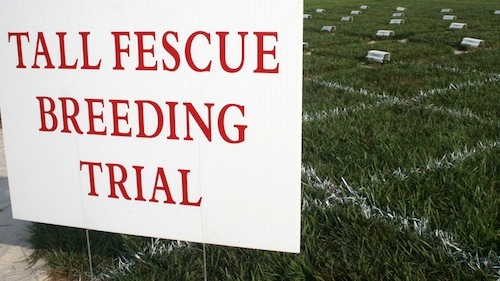To successfully establish a new tall fescue lawn or interseed an existing lawn, consider the following techniques and practices from University of Georgia Cooperative Extension.
Grass seeded earlier than September or October is subject to heat stress and diseases. Planting later leaves the plant vulnerable to cold weather. Seeding in December and early spring is generally not recommended because the plant does not have adequate time to develop a deep root system needed to survive Georgia’s hot summers.
Preemergence herbicides are needed to minimize weed pressure. These herbicides pose the least amount of risk to tall fescue that was seeded the previous September and October. Tall fescue seeded in November and treated with preemergence herbicides the following February has lower turfgrass quality ratings and reduced stand density compared to tall fescue seeded in October.
Proper soil preparation is critical for effective seed establishment. Ridding the lawn of debris, tilling, incorporating lime and fertilizer and smoothing the surface are all necessary prior to seeding.
Add amendments, like organic matter or topsoil, for soil improvement and till thoroughly into the existing soil. After initial preparation is completed and the area is properly leveled, collect a soil sample to obtain soil fertilizer recommendations. Submit soil samples to the local UGA Extension office. If starter fertilizer and lime are recommended, incorporate 3 to 4 inches into the soil. Tilling deeper is always better.
To ensure you plant high-quality pure seed, search for the blue certified seed tag on the bag. In the retail market, most tall fescue seed is available as a blend of several tall fescue cultivars. Single cultivars are also available but often at a higher price.
The ideal seeding rate for tall fescue is 5 to 6 pounds per 1,000 square feet. To minimize skips and gaps, divide the seed into two equal portions and broadcast half in one direction and the remainder at a right angle to the first direction.
The seed can be lightly raked into the upper quarter-inch of soil or pressed into the seedbed with a roller. Apply a straw mulch to retain moisture for improved germination and prevent erosion.
After seeding, keep the upper 1 to 2 inches of soil moist, not wet, for uniform germination. This usually means daily watering of about one-tenth to one-quarter inch for the first three weeks. As the seedlings develop, irrigate less frequently but wet the soil profile deeper. Under good conditions, tall fescue seed will germinate in 5 to 10 days and be ready for its first mowing between 2 and 3 weeks.
Begin mowing at a height of 2 inches. As the seedlings mature, raise the cutting height to the 2.5- to 3-inch range. Once mature, the lawn can be maintained between 2 to 2.5 inches, but a height of 3 inches is suggested during the summer months. Use a mower with a sharp blade and mow often enough so no more than a third of the leaf height is removed in a single mowing. Do not mow a grass, especially young seedlings, when it’s wet.
If the lawn needs reseeding, estimate the percentage of tall fescue loss and multiply that number by the establishment seeding rate of 6 pounds per 1,000 square feet. For example, if 50 percent (0.5) of the stand is lost, reseed with 0.5 x 6 = 3 pounds per 1,000 square feet. Spring reseeding is less successful because of the shorter establishment time before summer heat and moisture stress.
Seed-to-soil contact is necessary to assure successful reseeding. First, mow the lawn at a height of 1 to 1.5 inches. Disturb the soil by coring or vertical mowing before and/or after seed distribution. (Equipment for this task is available at rental or garden centers.) Reseed thin areas at 2 to 6 pounds per 1,000 square feet. Getting the seed below the existing turfgrass canopy and to the soil surface improves germination. Apply a starter fertilizer at 1 pound of nitrogen per 1,000 square feet. Lastly, keep the soil moist as discussed for new lawn establishment.
Successful seeding depends on proper soil preparation, good soil-to-seed contact and proper water management.








